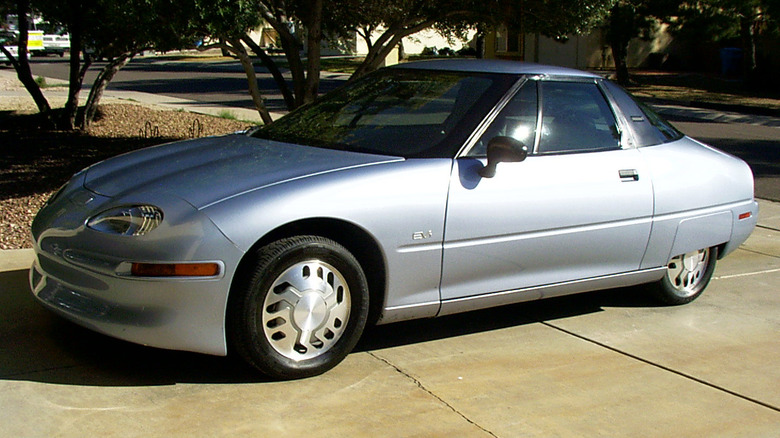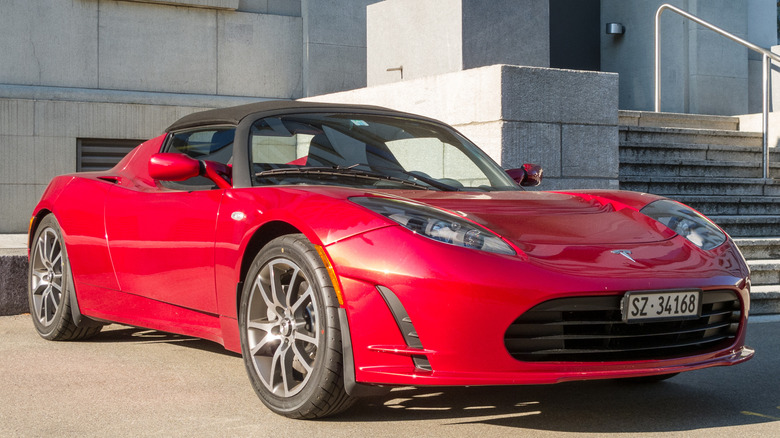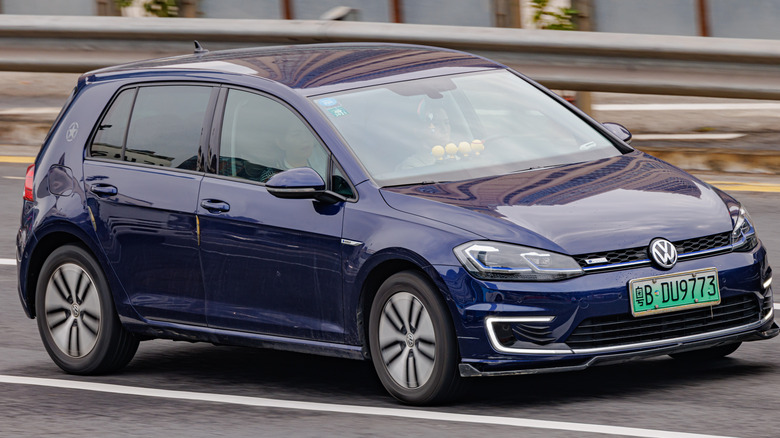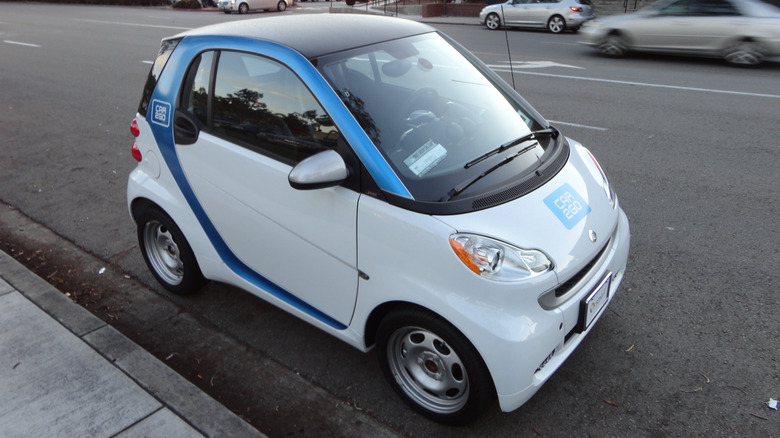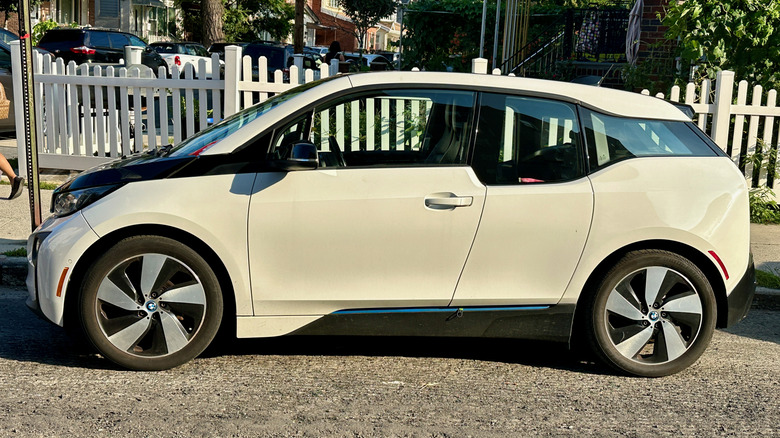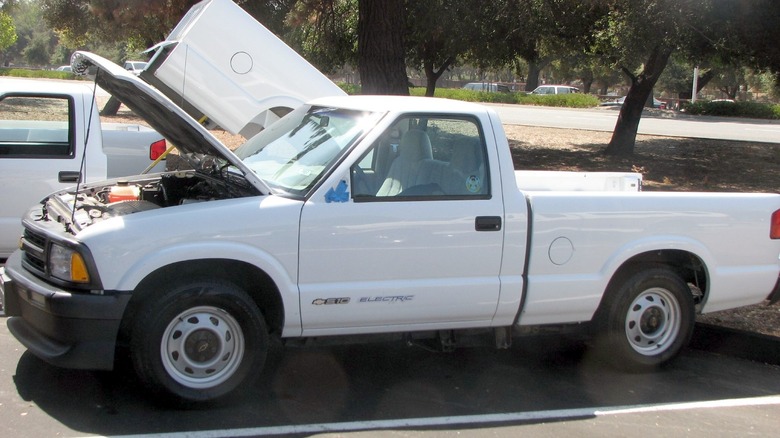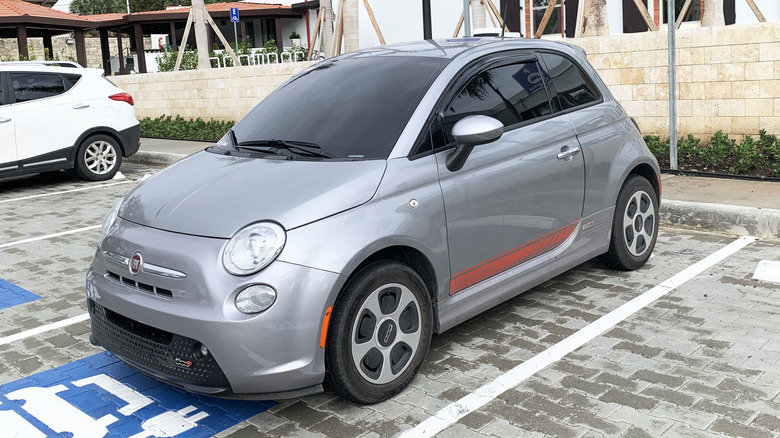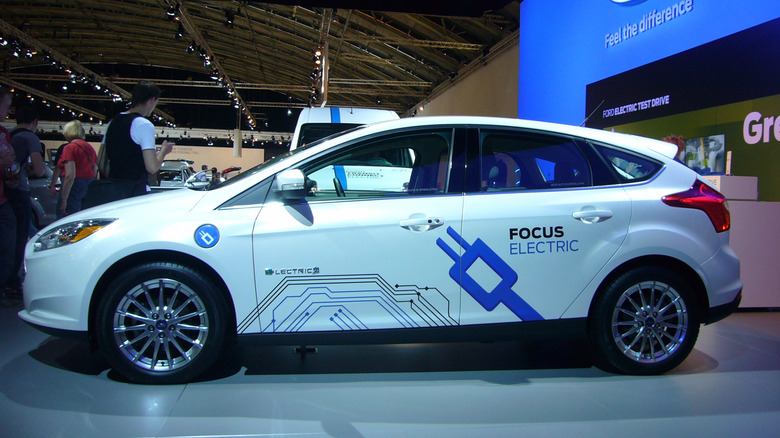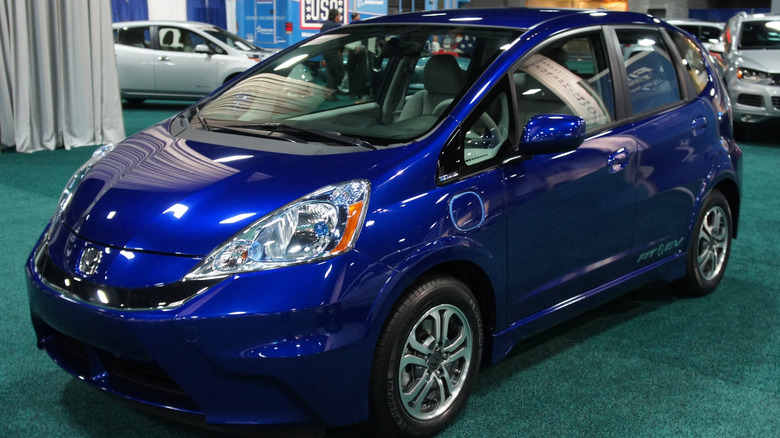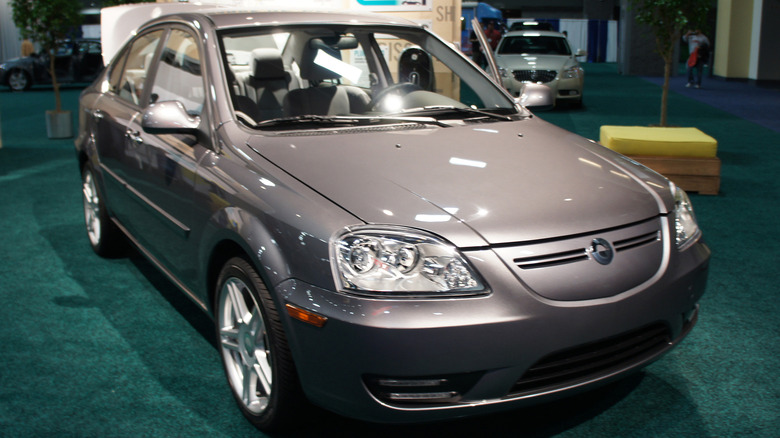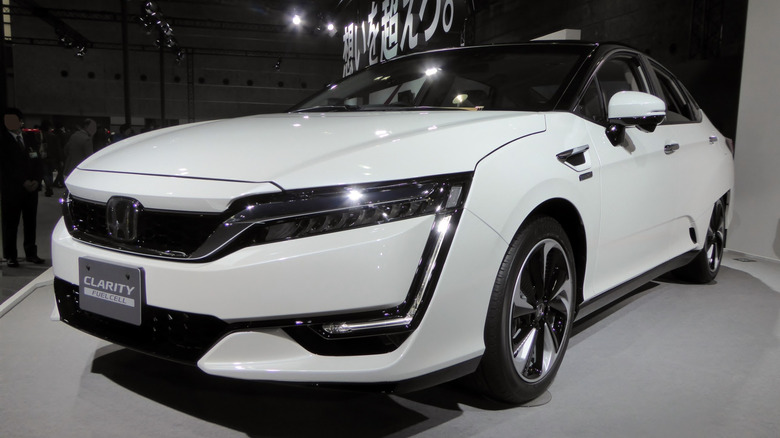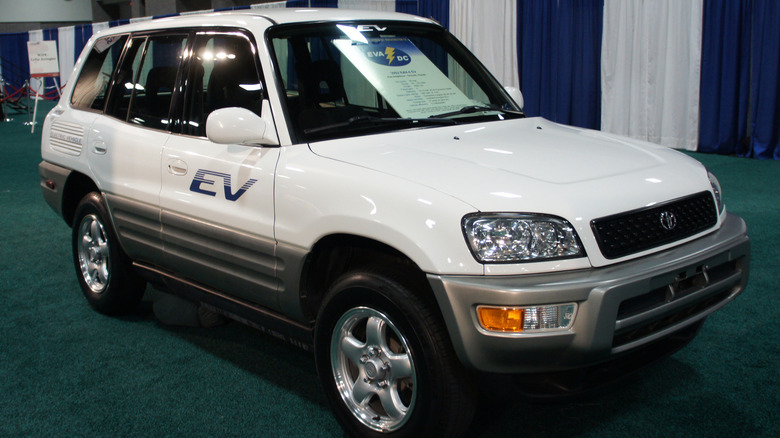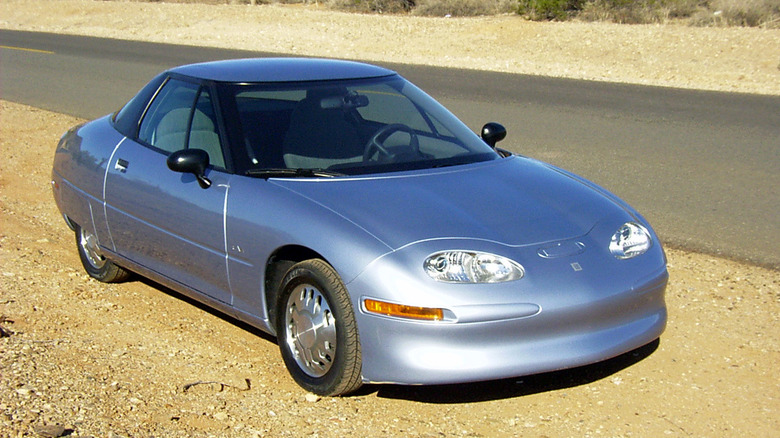13 EVs That Have Been Discontinued In The US
One day, we'll look back at the modern era of gas-guzzling cars like it was the dark ages. But for now, we're still in the early stages of the electric vehicle revolution. Every year, more and more drivers trade in their gas-powered vehicles for hybrid, or even fully electric, vehicles. While electric and hybrid vehicles aren't perfect with their limited range and oversized batteries, they offer superior fuel efficiency, smoother, quieter engine performance and can help the driver save money in the long run.
There's a lot of road ahead for electric vehicles, but it's also been a long road to get the EV industry to where it currently stands. While the current generation of EVs is a stepping stone to what the future holds, there are plenty of EVs that have been left in the past. Let's take a look back at some electric cars that are no longer with us, so to speak. Here are 13 EVs that have been discontinued in the U.S.
Tesla Roadster
Though Tesla might be more well known these days for its eccentric CEO than for any of its innovative products, it's easy to forget that the company originally made a name for itself producing fully electric cars. The Tesla Roadster, originally launched in 2008, wasn't the first-ever electric car, but it was a major milestone for the EV movement, with its profile and performance going a long way toward making EVs mainstream and not just for dorks who care for the environment and want to keep the planet alive for future generations.
Ultimately, the Roadster was discontinued in 2012, partially because it could not be sold in the United States due to airbag regulations. Even so, existing Roadsters could be upgraded with improved engines until late 2016. To Tesla's credit, they made parts of the Roadster's design "open source," allowing other EV manufacturers to use Tesla's tools to create their own electric vehicles. In 2017, Tesla announced a second-generation Roadster, though as of 2025, the car remains unreleased, with some wondering if Tesla will ever release the car, or if their days of innovation and environmental consciousness are behind them.
Volkswagen E-Golf
The Volkswagen Golf, first introduced in 1974, remains one of the German auto manufacturer's flagship vehicles to this day. It's a cozy family compact that has sold over 35 million units as of 2019. Volkswagen experimented with concepts for a Twin Drive hybrid version of the Golf, but those plans never came to fruition. Instead, it developed a fully electric version, aptly called the Volkswagen e-Golf.
The e-Golf lasted from 2014 to 2020, when it was discontinued. It's effectively been replaced by Volkswagen's ID (Intelligent Design) series, which are original models not directly based on already-existing cars. Perhaps this is for the best, as EVs deserve to have their own unique visual and style profile, rather than being adapted versions of other cars. Then again, as EVs become more and more ubiquitous as the years roll by, maybe there doesn't need to be a visual distinction between traditional diesel vehicles, hybrid cars, and electric cars. With that in mind, the e-Golf is currently not in production, but we wouldn't be surprised if it makes a comeback in the future.
Smart Fortwo ED
There's nothing cuter than a Smart car, made by Mercedes-Benz. You know, those adorable little shoeboxes that look incapable of carrying the 200-pound frame of the average American man. Joking aside, the Smart Fortwo microcar was inexpensive, fuel-efficient, and could fit in even the tightest of parking spaces. The gas-powered version was discontinued in 2017, with the company focusing squarely on electric vehicles. Alas, sales of the Fortwo never hit expectations, and the vehicle's availability in America was discontinued in 2019. Perhaps American sensibilities can't help but lean towards the "bigger is better" mentality, or perhaps the Fortwo was just too pure for this world.
Maybe the Fortwo will make a comeback in the U.S., perhaps with a slightly larger frame. You know, something big enough for Americans to enjoy without compromising the itty-bitty sensibilities of the brand. In the meantime, Mercedes-Benz has plenty of other electric options, such as the EQB, a crossover SUV that should satisfy fans of electric vehicles who also want something fit for a soccer mom with a gaggle of kids and a trunk full of groceries.
BMW i3
The BMW i3, launched in 2013, marked a historical milestone for the German auto manufacturer, being its first-ever "zero emissions" vehicle. Of course, there's a bit more to it than that, considering the environmental impact of battery production and electrical power, but it's generally understood to be a whole lot cleaner than traditional gas-powered cars. It wasn't pretty, with its boxy design and unflattering curves, and it didn't go particularly far, with a paltry 81-or-so mile range in all-electric mode, but it was an important car that helped make EVs more mainstream than ever before.
BMW pumped out the i3 for 10 years, selling around 50,000 units in the U.S., but it wasn't quite enough to set the world on fire ... not in the same way that gas-powered cars set the world on fire with the effects of greenhouse gases on climate change. It was found that EV enthusiasts and BMW fanatics didn't quite occupy the same space. The people buying the i3 were EV fans, which meant there was no guarantee of repeat business, as there was no brand loyalty to BMW.
As a result, subsequent BMW EVs have been more directly based on existing BMW models, like the i5 and i7 series. This way, BMW is turning existing customers into EV fans, rather than simply preaching to the converted choir.
Chevrolet S-10 EV
Electric cars had, and to an extent, still have a reputation as being less powerful than their gas-powered counterparts, aiming for smaller frames, having weaker motors, and being incompatible with the American image of a dude with tight jeans and an oversized belt buckle driving a hearty pickup truck through a muddy, but scenic, forest setting. With that in mind, you might be surprised to learn that Chevrolet developed its first all-electric pickup truck way back in 1996. The first model of the Chevrolet S-10 EV had a range of well under 50 miles, but for an electric pickup truck in the mid-1990s, that's not bad. It's not great by any metric, but it was a different time.
Ultimately, the S-10 was more of a proof-of-concept than a proper consumer product. During its two-year lifespan, fewer than 500 units were assembled, so most consumers probably didn't even know it existed. Nevertheless, the S-10 was an important milestone in the history of the electric car, and paved the way for vehicles like the Chevrolet Silverado EV, a hefty pickup truck with a range upwards of 400 miles. "Like a Rock," indeed.
Fiat 500e
Like the Smart Fortwo, the Fiat 500e was another attempt to put large Americans into small cars. Americans are usually tall, barrel-chested, broad-shouldered people. They don't really do tiny cars. Still, it was a noble effort, even if it was doomed to inevitable failure.
The original Fiat 500 goes back to 2007, with the all-electric version making its American debut in 2013. According to Sergio Marchionne, the big boss of Fiat at the time, the 500e was sold at a loss, with the company losing $14,000 per vehicle. According to him, the car was made specifically to be sold in states like California and Oregon, states where auto manufacturers were legally required to sell carbon-efficient cars.
The Fiat 500e was discontinued in 2019, though a revamped version launched as the "New Fiat 500" in Europe before inheriting the 500e name. Limited numbers of the newer vehicles were sold in the USA, beginning in 2024. The newer 500e is a bit bulkier than the old model, so maybe it'll catch on this time, if Fiat gives the car a proper marketing push. Maybe they should include it in the next "Fast & Furious" movie!
Ford Focus Electric
Visually, the Ford Focus Electric is virtually indistinguishable from its gas-powered counterpart, the Ford Focus. Of course, the main difference is the presence of a big ol' battery instead of a traditional engine. The electric Focus was first put on sale in 2011 and lasted until 2018 before being discontinued. All told, around 9,000 units of the car were sold, and it even won an award from the Environmental Protection Agency for being the most fuel-efficient vehicle of its class.
As for the regular Ford Focus, it was discontinued just this year, ironically due in part to Ford's increased focus (no pun intended) on electric vehicles. The future is all-electric. One day, gas-powered vehicles will be a relic of the distant past. That day probably isn't soon, but it will inevitably come. And when it does, vehicles like the Ford Focus Electric will either be fondly remembered, or maybe they'll make a righteous comeback!
Honda Fit EV
The Honda Fit began production in 2001 and remains in production today, though not in North America (in other countries, it's called the Honda Jazz). But at least it proved more popular than its EV variant, of which only 1,100 units were produced between 2012 and 2014 before being discontinued. The four-door subcompact/supermini (not a sedan, not quite a minivan) was unable to break out, and its range of less than 100 miles just wasn't good enough by 2014.
As a "lease-only" vehicle, with no option to actually buy-to-own, the Honda Fit EV is an exceptionally rare vehicle to spot on the road these days. In fact, that's kind of a problem with a lot of EVs, since batteries degrade differently from traditional combustion engines. As entirely different technologies, it's not as simple as bringing your car to the local mechanic who can breathe new life into an old engine. When it comes to EVs, battery repair is a completely different beast and requires entirely different training from what most mechanics have been taught for the last 100 years. Ultimately, this may become less of a problem as EVs become more commonplace and mechanics learn how to work with EV batteries alongside old-school engines.
Coda EV
Sometimes, an idea is just a bit ahead of its time. Enter the Coda EV, the product of a startup company that sought to become the preeminent name in electric cars. Alas, 'twas not to be. The Coda failed to stand out from the crowd of competing vehicles. Essentially, the Coda was little more than a reformulated version of the Chinese Hafei Saibao III, an unremarkable vehicle converted into an electric car.
The Coda was unsuccessful, selling just 117 units during its limited time on shelves. Or whatever the equivalent of "shelves" is for cars. The Coda was only available from 2012 to 2013 before Coda filed for bankruptcy. During Coda's extremely brief heyday, the company's vehicle sold for well over $30,000. In 2023, Coda made headlines one last time when a unit that fell through the proverbial cracks was sold to YouTube persona Kyle of Out of Spec Reviews for the price of one dollar.
Ford Ranger EV
Chevrolet may have beaten Ford to the punch by a couple of years, but the 1998 debut of the Ford Ranger EV proved that electric pickup trucks would be a key part of the inevitable electric future. Perhaps due to its experimental nature (it was Ford's first EV, after all), the Ranger generally wasn't sold directly to consumers, but units were leased instead. The truck ended its run in 2002. As a result of the relatively tight leash Ford kept on the vehicle, leased vehicles were recalled, though a precious few remain out in the wild to this day ... in Norway, of all places.
While they might not seem like much today, vehicles like Chevy's S-10 and Ford's Ranger EV pickup trucks will be remembered for their role in showing people of the 1990s that there was, in fact, a future for powerful electric vehicles. That future might not have arrived as quickly as some might have hoped, but there are more EVs and hybrids on the road today than ever before, and that number will only grow as the years go by and gas prices continue to rise. Many budget-conscious American drivers would rather not allocate a large share of their spending to gasoline.
Honda Clarity Electric
There were several different versions of the Honda Clarity over the years. "Clarity" is less of a specific model than it is a catch-all for Honda's quasi-experimental vehicles using alternative fuel sources. One variant was the Hydrogen Fuel Cell vehicle. Hydrogen is prohibitively expensive and inefficient, not to mention highly explosive. That version of the vehicle lasted from 2008 to 2014. Meanwhile, the Honda Clarity Electric was phased out in 2020, possibly due to consumer apathy toward its range of less than 100 miles.
These days, consumers lean more towards hybrid cars than straight-up electric power. While not as totally carbon neutral as an EV, a hybrid vehicle is more versatile. While being entirely carbon-safe is a great victory, the fact of the matter remains that a little bit of old-school gasoline power can go a really long way. And when it comes to "a really long way," 100 miles of range just isn't enough for the hustle and bustle of the average driver in 2025.
Toyota RAV4 EV
As electric vehicles grew in popularity, automobile manufacturers sought to integrate the technology into more and more different types of vehicles. These days, it seems like almost every type of car has a hybrid or electric alternative. One of the more notable conversions was the Toyota RAV4 EV, first introduced in 1997. Despite being discontinued in 2003, Toyota decided to take another crack at it a full decade later, in 2012. This revamped RAV4 was developed in conjunction with Tesla.
Comparing the two RAV4 EV models is a great way to look at how EV technology evolved over a relatively short period of time. The original RAV4 EV got 95 miles of range out of its battery, which supplied the vehicle with 68 horsepower under the hood. Meanwhile, the newer RAV4 EV from 2012 had a range of 103 miles, so not too much of an improvement. In terms of power, however, the 2012 version boasted an impressive 154 horsepower, which is more than enough to get a keen driver through the shallow creeks and over the rocky hills.
The redux version of the RAV4 EV was discontinued in 2014, and Toyota broke off their partnership with Tesla in 2017. Modern RAV4 SUVs have hybrid options, eschewing fully electric power for an approach that uses both electricity and gasoline for maximum flexibility.
GM EV-1
In the modern era, the General Motors EV-1 is considered to be the first electric car of its kind, and the father of all EVs that came after it. I mean, it's right there in the name: EV-1. Like all forebearers of modern standards, the EV-1 was ahead of its time and failed to make much of an impression on the market. After all, back in 1996, there weren't electric car chargers in every gas station like there are today.
However, if you need evidence that the EV-1 was the herald of the future, look no further than the 1994 rise of Californians Against Utility Company Abuse (CAUCA). It may sound like a grassroots organization, but it was actually funded by Big Oil to sabotage the EV-1 and throw shade at the notion of electric vehicles in general by trying to reduce public funding for vehicles fueled by gasoline alternatives.
In a way, CAUCA was successful, since the EV-1 failed to make much of an immediate impact and was quietly discontinued in 1999 after just over 1,000 units were sold. Then again, the efforts sparked by the EV-1 showed consumers and other automakers that electric vehicles were the wave of the future. While the efforts of the rich and powerful can slow the inevitable march of progress, nothing can truly stop the future, and electric cars, then and now, are the future.
